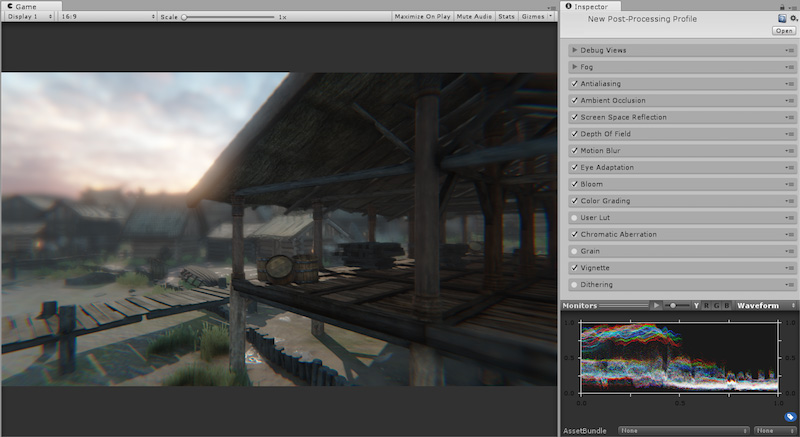Post-processing stack
The post-processing stack is an über effect that combines a complete set of effects into a single post-processing pipeline. This has a few advantages:
Effects are always configured in the correct order
It allows a combination of many effects into a single pass
All effects are grouped together in the UI(User Interface) Allows a user to interact with your application. More info
See in Glossary for a better user experience
The post-processing stack also includes a collection of monitors and debug views to help you set up your effects correctly and debug problems in the output.
To use post-processing, download the post-processing stack from the Asset StoreA growing library of free and commercial assets created by Unity and members of the community. Offers a wide variety of assets, from textures, models and animations to whole Project examples, tutorials and Editor extensions. More info
See in Glossary.

For help on how to get started with the post-processing stack, see Setting up the post-processing stack.
Effects
- Anti-aliasing (FXAA & TAA)
- Ambient OcclusionA method to approximate how much ambient lighting (lighting not coming from a specific direction) can hit a point on a surface. More info
See in Glossary - Screen Space Reflection
- FogA post-processing effect that overlays a color onto objects depending on the distance from the camera. Use this to simulate fog or mist in outdoor environments, or to hide clipping of objects near the camera’s far clip plane. More info
See in Glossary - Depth of FieldA post-processing effect that simulates the focus properties of a camera lens. More info
See in Glossary - Motion BlurA common post-processing effect that simulates the blurring of an image when objects filmed by a camera are moving faster than the camera’s exposure time. More info
See in Glossary - Eye Adaptation
- BloomA post-processing effect used to reproduce an imaging artifact of real-world cameras. The effect produces fringes of light extending from the borders of bright areas in an image, contributing to the illusion of an extremely bright light overwhelming the camera or eye capturing the scene.
See in Glossary - Color Grading
- User Lut
- Chromatic Aberration
- Grain
- Vignette
- Dithering
For details about each individual effect included in the stack see the page for that effect.
Post-processing stack version 2
For an early preview of the next version of the post processingA process that improves product visuals by applying filters and effects before the image appears on screen. You can use post-processing effects to simulate physical camera and film properties, for example Bloom and Depth of Field. More info
See in Glossary stack, see Post-processing Stack v2 .
2017–09–04 Page amended with limited editorial review
New feature in 5.6
Added a link to the Post-processing Stack v2 GitHub branch, which is available as a preview in 2017.1 NewIn20171